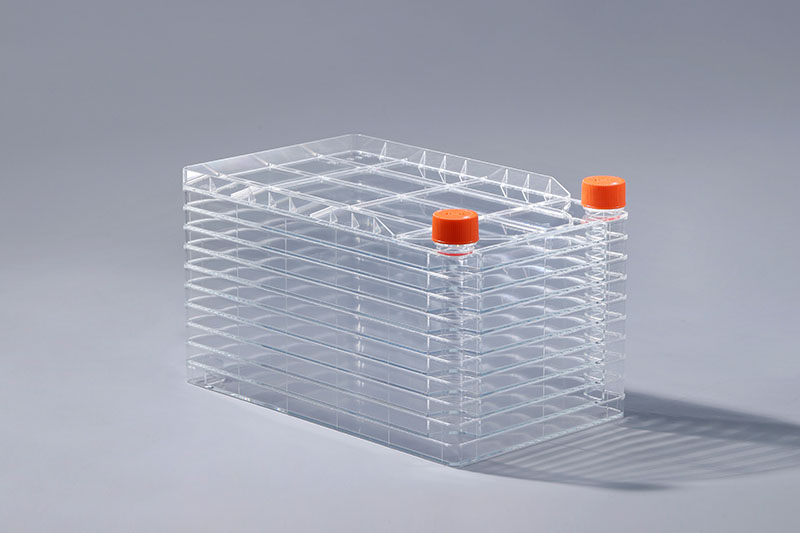कोशिका जीव विज्ञान अनुसंधान विधियों में सेल कल्चर एक महत्वपूर्ण और आमतौर पर इस्तेमाल की जाने वाली तकनीक है। सेल कल्चर के माध्यम से, बड़ी संख्या में सेल प्राप्त किए जा सकते हैं, और सेल कल्चर के माध्यम से सेल सिग्नल ट्रांसडक्शन, सेल एनाबोलिज्म, सेल ग्रोथ और प्रोलिफरेशन का अध्ययन किया जा सकता है। बड़े पैमाने पर सेल कल्चर में, cell factory एक कुशल और आमतौर पर इस्तेमाल की जाने वाली सेल कल्चर है। , 10 परतें, 40 परतें, आदि। परतें उत्पाद की दृढ़ता सुनिश्चित करने के लिए एक विशेष चिपकने वाली प्रक्रिया द्वारा जुड़ी हुई हैं। कंटेनर की सतह की हाइड्रोफिलिसिटी में सुधार करने और इसे सेल के विकास और प्रजनन के लिए अधिक उपयुक्त बनाने के लिए, यह उपभोज्य विशेष सतह उपचार से गुजरना होगा ताकि हाइड्रोफोबिक सतह पर हाइड्रोफिलिक समूहों को पेश किया जा सके ताकि कोशिकाओं के पालन को बढ़ाया जा सके और कम कोशिकाओं के लिए इसे आसान बनाया जा सके। आसंजन विशेषताएँ दीवार से चिपकी रहती हैं। कोशिकाओं, DF-1 कोशिकाओं, ST कोशिकाओं, PK15 कोशिकाओं, Mar145 कोशिकाओं और अन्य अनुगामी कोशिकाओं। यह सीएचओ कोशिकाओं, कीट कोशिकाओं, बीएचके 21 कोशिकाओं और एमडीसीके कोशिकाओं जैसे निलंबन कोशिकाओं की स्थिर संस्कृति के लिए भी उपयुक्त है। सेल संदूषण की संभावना को कम करना। यह व्यापक रूप से वैक्सीन विकास और सेल औद्योगिक उत्पादन में उपयोग किया जाता है।
The cell factory consists of one or more layers, the common ones are 1 layer, 2 layers, 5 layers, 10 layers, 40 layers, etc. The layers are connected by a special adhesive process to ensure the firmness of the product. In order to improve the hydrophilicity of the container surface and make it more suitable for cell growth and reproduction, this consumable will undergo special surface treatment to introduce hydrophilic groups on the hydrophobic surface to enhance the adherence of cells and make it easier for cells with low adhesion characteristics stick to the wall.
The cell factory is mainly suitable for the culture of a variety of adherent cells, such as Vero cells, HEK 293 cells, CAR-T cells, MRC5, CEF cells, porcine alveolar macrophages, myeloma cells, DF-1 cells, ST cells, PK15 cells, Marc145 cells and other adherent cells. It is also suitable for static culture of suspension cells such as CHO cells, insect cells, BHK21 cells and MDCK cells.
Using cell factories for large-scale cell culture can reduce space, save manpower, and have a larger culture area while reducing the possibility of cell contamination. It is widely used in vaccine development and cell industrial production.
The FAI climbed 5.9 percent year-on-year in the first 11 months of 2018, quickening from the 5.7-percent growth in Jan-Oct, the National Bureau of Statistics (NBS) said Friday in an online statement.
The key indicator of investment, dubbed a major growth driver, hit the bottom in August and has since started to rebound steadily.
In the face of emerging economic challenges home and abroad, China has stepped up efforts to stabilize investment, in particular rolling out measures to motivate private investors and channel funds into infrastructure.
Friday's data showed private investment, accounting for more than 60 percent of the total FAI, expanded by a brisk 8.7 percent.
NBS spokesperson Mao Shengyong said funds into weak economic links registered rapid increases as investment in environmental protection and agriculture jumped 42 percent and 12.5 percent respectively, much faster than the average.
In breakdown, investment in high-tech and equipment manufacturing remained vigorous with 16.1-percent and 11.6-percent increases respectively in the first 11 months. Infrastructure investment gained 3.7 percent, staying flat. Investment in property development rose 9.7 percent, also unchanged.
 English
English



















































